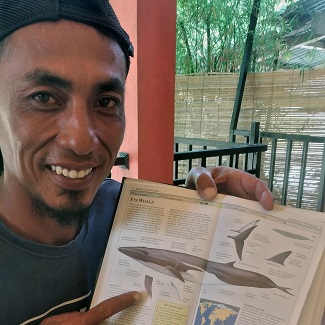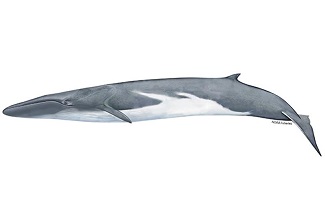Loading content - please wait...
Fin whale startles crew
Fin whale surfaced right next to one of our staff while he was fishing for yellowfin tuna. Tomini Bay where we dive is over four kilometers deep. So, large cetaceans are part of the marine environment in Gorontalo.
Surprise Encounter
Boka, one of Miguel’s Diving dive masters, headed to deep waters offshore. On his day off, he decided to fish for yellowfin tuna. Local fishermen use traditional handlines. This method is ecologically sustainable.
Suddenly, a large whale surfaced only a few meters away from his outrigger canoe. Then the whale exhaled, sending spray into the air.
Boka’s outrigger canoe measures five meters in length. He estimates the fin whale that surfaced next to him to be twelve meters. That means this particular whale was still small. Adult fin whales can reach 22 meters in length. This species is the second largest animal on planet earth, after the larger Blue whale. The cetaceans we see tend to be young. That includes whale sharks, orcas, and whales. It seems that the deep waters of Tomini Bay are a prime location for young cetaceans to grow into adults.
Fin Whale in the Southern Hemisphere
Although fin whales live in all the world’s oceans
, they are mostly sighted in the southern hemisphere. When a fin whale surfaces, its dorsal fin appears right after the whale blows. The dorsal fin is quite small and points backwards. Its flukes are rarely visible. Most notable, it is large size. Also, fin whales ignore boats. This is what happened when Boka encountered one.The fin whale used to be hunted commercially. This is now banned. As a result of over hunting, this species is considered endangered. The population of the southern hemisphere has been particularly slow to recover. Balaenoptera physalus is the scientific name.
Fin whales are filter feeders. Those in the southern hemisphere feed almost exclusively on krill. They can also eat plankton, small schooling fish, and squids. Their only known predator is the Orca or killer whale. In Gorontalo we see orca annually, usually in January and February.
Although scuba divers are not likely to see a fin whale in Gorontalo, whale shark sightings are common. So, please make your dive reservations directly with Miguel’s Diving.







